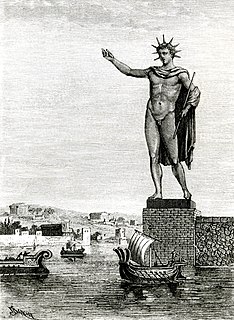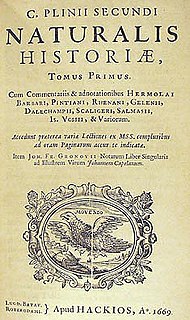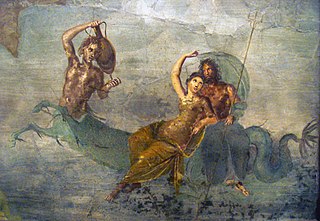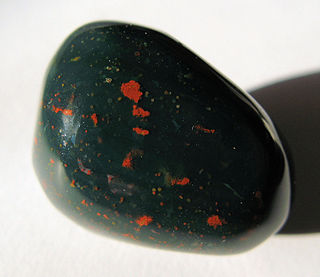Related Research Articles

Gaius Plinius Secundus, called Pliny the Elder, was a Roman author, naturalist and natural philosopher, and naval and army commander of the early Roman Empire, and a friend of the emperor Vespasian. He wrote the encyclopedic Naturalis Historia, which became an editorial model for encyclopedias. He spent most of his spare time studying, writing, and investigating natural and geographic phenomena in the field.

The Colossus of Rhodes was a statue of the Greek sun-god Helios, erected in the city of Rhodes, on the Greek island of the same name, by Chares of Lindos in 280 BC. One of the Seven Wonders of the Ancient World, it was constructed to celebrate the successful defence of Rhodes city against an attack by Demetrius Poliorcetes, who had besieged it for a year with a large army and navy.

The Natural History is a work by Pliny the Elder. The largest single work to have survived from the Roman Empire to the modern day, the Natural History compiles information gleaned from other ancient authors. Despite the work's title, its subject area is not limited to what is today understood by natural history; Pliny himself defines his scope as "the natural world, or life". It is encyclopedic in scope, but its structure is not like that of a modern encyclopedia. It is the only work by Pliny to have survived, and the last that he published. He published the first 10 books in AD 77, but had not made a final revision of the remainder at the time of his death during the AD 79 eruption of Vesuvius. The rest was published posthumously by Pliny's nephew, Pliny the Younger.

Neptune is the god of freshwater and the sea in Roman religion. He is the counterpart of the Greek god Poseidon. In the Greek tradition, he is a brother of Jupiter and Pluto; the brothers preside over the realms of heaven, the earthly world, and the underworld. Salacia is his wife.

Polykleitos was an ancient Greek sculptor in bronze of the 5th century BCE. Alongside the Athenian sculptors Pheidias, Myron and Praxiteles, he is considered one of the most important sculptors of classical antiquity. The 4th century BCE catalogue attributed to Xenocrates, which was Pliny's guide in matters of art, ranked him between Pheidias and Myron. He is particularly known for his lost treatise, the Canon of Polykleitos, setting out his mathematical basis of an idealised male body shape.

Scandza was described as a "great island" by Gothic-Byzantine historian Jordanes in his work Getica. The island was located in the Arctic regions of the sea that surrounded the world.

Lucius Junius Moderatus Columella was a prominent writer on agriculture in the Roman empire.

The Getae or Gets were a Thracian-related tribe that once inhabited the regions to either side of the Lower Danube, in what is today northern Bulgaria and southern Romania. Both the singular form Get and plural Getae may be derived from a Greek exonym: the area was the hinterland of Greek colonies on the Black Sea coast, bringing the Getae into contact with the ancient Greeks from an early date. Although it is believed that the Getae were related to their westward neighbours, the Dacians, several scholars, especially in the Romanian historiography, posit that the Getae and the Dacians were the same people.

Coele-Syria alternatively Coelo-Syria or Coelosyria, was a region of Syria in classical antiquity. It probably derived from the Aramaic word for all of the region of Syria, but it was most often applied to the Beqaa Valley between the Lebanon and the Anti-Lebanon mountain ranges. The area is now part of the modern-day Syria and Lebanon.
Diocles of Carystus was a well-regarded Greek physician, born in Carystus, a city on Euboea, Greece. His significance was as a major thinker, practitioner, and writer of the fourth century.

In ancient Greek religion and myth, the Anemoi were wind gods who were each ascribed a cardinal direction from which their respective winds came, and were each associated with various seasons and weather conditions. They were the progeny of Eos and Astraeus.

The mineral aggregate heliotrope, also known as bloodstone, is a cryptocrystalline mixture of quartz that occurs mostly as jasper (opaque) or sometimes as chalcedony (translucent). The "classic" bloodstone is opaque green jasper with red inclusions of hematite. The red inclusions may resemble spots of blood, hence the name bloodstone. The name heliotrope derives from various ancient notions about the manner in which the mineral reflects light. Such notions are described, for example, by Pliny the Elder.
The salamander is an amphibian of the order Urodela which, as with many real creatures, often has been ascribed fantastic and sometimes occult qualities by pre-modern authors not possessed by the real organism. The legendary salamander is often depicted as a typical salamander in shape with a lizard-like form, but is usually ascribed an affinity with fire, sometimes specifically elemental fire.

Vulcan is the god of fire including the fire of volcanoes, deserts, metalworking and the forge in ancient Roman religion and myth. He is often depicted with a blacksmith's hammer. The Vulcanalia was the annual festival held August 23 in his honor. His Greek counterpart is Hephaestus, the god of fire and smithery. In Etruscan religion, he is identified with Sethlans.

In classical mythology, Cupid is the god of desire, erotic love, attraction and affection. He is often portrayed as the son of the love goddess Venus and the god of war Mars. He is also known in Latin as Amor ("Love"). His Greek counterpart is Eros. Although Eros is generally portrayed as a slender winged youth in Classical Greek art, during the Hellenistic period, he was increasingly portrayed as a chubby boy. During this time, his iconography acquired the bow and arrow that represent his source of power: a person, or even a deity, who is shot by Cupid's arrow is filled with uncontrollable desire. In myths, Cupid is a minor character who serves mostly to set the plot in motion. He is a main character only in the tale of Cupid and Psyche, when wounded by his own weapons, he experiences the ordeal of love. Although other extended stories are not told about him, his tradition is rich in poetic themes and visual scenarios, such as "Love conquers all" and the retaliatory punishment or torture of Cupid. His powers are similar, though not identical, to Kamadeva, the Hindu god of human love.
Sextius Niger was a Roman writer on pharmacology during the reign of Augustus or a little later. He may be identical with the son of the philosopher Quintus Sextius, who continued his philosophical teachings.

Ver sacrum is a religious practice of ancient Italic peoples, especially Sabines and their offshoot Samnites, concerning the deduction of colonies. It was of special interest to Georges Dumézil, according to whom the ver sacrum perpetuated prehistoric migration practices of Indo-Europeans to the end of the Iron Age and into the beginnings of history, when stable sedentary dwelling conditions had already become general.

Between the first century BC and the fourth century AD, several expeditions and explorations to Lake Chad and western Africa were conducted by groups of military and commercial units of Romans who moved across the Sahara and into the interior of Africa and its coast. The primary motivation for the expeditions was to secure sources of gold and spices.
This article presents a timeline of the name Judea through an incomplete list of notable historical references to the name through the various time periods of the region.

For the ancient Greeks, “India" referred to the polity situated east of Persia and south of the Himalayas. Although, during different periods of history, "India" referred to a much wider or much less extensive place. The Greeks referred to the ancient Indians as "Indói" ; the Indians referred to the Greeks as "Yonas (Yavanas)" in reference to the Ionians.
References
- 1 2 W. Smith (1870). "NIGER, TRE'BIUS". Dictionary of Greek and Roman biography and mythology. Vol. 2. p. 1202. Archived from the original on 2015-04-07. Retrieved 9 April 2015– via The Ancient Library.
- ↑ Beullens, Pieter. Like a Book Written by God's Finger: Animals Showing the Path toward God, in A Cultural History of Animals in the Medieval Age, ed. Brigitte Resl, 2009.